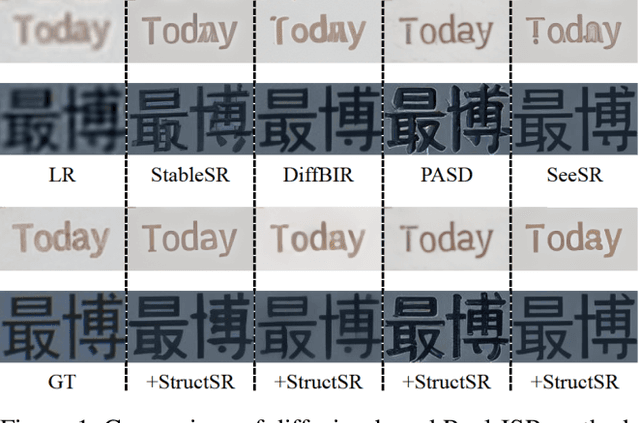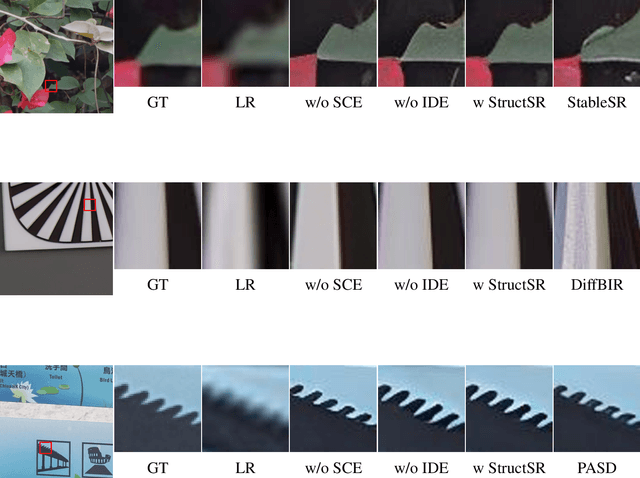Tianyu Ding
ProCrop: Learning Aesthetic Image Cropping from Professional Compositions
May 28, 2025Abstract:Image cropping is crucial for enhancing the visual appeal and narrative impact of photographs, yet existing rule-based and data-driven approaches often lack diversity or require annotated training data. We introduce ProCrop, a retrieval-based method that leverages professional photography to guide cropping decisions. By fusing features from professional photographs with those of the query image, ProCrop learns from professional compositions, significantly boosting performance. Additionally, we present a large-scale dataset of 242K weakly-annotated images, generated by out-painting professional images and iteratively refining diverse crop proposals. This composition-aware dataset generation offers diverse high-quality crop proposals guided by aesthetic principles and becomes the largest publicly available dataset for image cropping. Extensive experiments show that ProCrop significantly outperforms existing methods in both supervised and weakly-supervised settings. Notably, when trained on the new dataset, our ProCrop surpasses previous weakly-supervised methods and even matches fully supervised approaches. Both the code and dataset will be made publicly available to advance research in image aesthetics and composition analysis.
Robust Dataset Distillation by Matching Adversarial Trajectories
Mar 15, 2025Abstract:Dataset distillation synthesizes compact datasets that enable models to achieve performance comparable to training on the original large-scale datasets. However, existing distillation methods overlook the robustness of the model, resulting in models that are vulnerable to adversarial attacks when trained on distilled data. To address this limitation, we introduce the task of ``robust dataset distillation", a novel paradigm that embeds adversarial robustness into the synthetic datasets during the distillation process. We propose Matching Adversarial Trajectories (MAT), a method that integrates adversarial training into trajectory-based dataset distillation. MAT incorporates adversarial samples during trajectory generation to obtain robust training trajectories, which are then used to guide the distillation process. As experimentally demonstrated, even through natural training on our distilled dataset, models can achieve enhanced adversarial robustness while maintaining competitive accuracy compared to existing distillation methods. Our work highlights robust dataset distillation as a new and important research direction and provides a strong baseline for future research to bridge the gap between efficient training and adversarial robustness.
DistiLLM-2: A Contrastive Approach Boosts the Distillation of LLMs
Mar 10, 2025Abstract:Despite the success of distillation in large language models (LLMs), most prior work applies identical loss functions to both teacher- and student-generated data. These strategies overlook the synergy between loss formulations and data types, leading to a suboptimal performance boost in student models. To address this, we propose DistiLLM-2, a contrastive approach that simultaneously increases the likelihood of teacher responses and decreases that of student responses by harnessing this synergy. Our extensive experiments show that DistiLLM-2 not only builds high-performing student models across a wide range of tasks, including instruction-following and code generation, but also supports diverse applications, such as preference alignment and vision-language extensions. These findings highlight the potential of a contrastive approach to enhance the efficacy of LLM distillation by effectively aligning teacher and student models across varied data types.
Automatic Joint Structured Pruning and Quantization for Efficient Neural Network Training and Compression
Feb 23, 2025Abstract:Structured pruning and quantization are fundamental techniques used to reduce the size of deep neural networks (DNNs) and typically are applied independently. Applying these techniques jointly via co-optimization has the potential to produce smaller, high-quality models. However, existing joint schemes are not widely used because of (1) engineering difficulties (complicated multi-stage processes), (2) black-box optimization (extensive hyperparameter tuning to control the overall compression), and (3) insufficient architecture generalization. To address these limitations, we present the framework GETA, which automatically and efficiently performs joint structured pruning and quantization-aware training on any DNNs. GETA introduces three key innovations: (i) a quantization-aware dependency graph (QADG) that constructs a pruning search space for generic quantization-aware DNN, (ii) a partially projected stochastic gradient method that guarantees layerwise bit constraints are satisfied, and (iii) a new joint learning strategy that incorporates interpretable relationships between pruning and quantization. We present numerical experiments on both convolutional neural networks and transformer architectures that show that our approach achieves competitive (often superior) performance compared to existing joint pruning and quantization methods.
StructSR: Refuse Spurious Details in Real-World Image Super-Resolution
Jan 16, 2025



Abstract:Diffusion-based models have shown great promise in real-world image super-resolution (Real-ISR), but often generate content with structural errors and spurious texture details due to the empirical priors and illusions of these models. To address this issue, we introduce StructSR, a simple, effective, and plug-and-play method that enhances structural fidelity and suppresses spurious details for diffusion-based Real-ISR. StructSR operates without the need for additional fine-tuning, external model priors, or high-level semantic knowledge. At its core is the Structure-Aware Screening (SAS) mechanism, which identifies the image with the highest structural similarity to the low-resolution (LR) input in the early inference stage, allowing us to leverage it as a historical structure knowledge to suppress the generation of spurious details. By intervening in the diffusion inference process, StructSR seamlessly integrates with existing diffusion-based Real-ISR models. Our experimental results demonstrate that StructSR significantly improves the fidelity of structure and texture, improving the PSNR and SSIM metrics by an average of 5.27% and 9.36% on a synthetic dataset (DIV2K-Val) and 4.13% and 8.64% on two real-world datasets (RealSR and DRealSR) when integrated with four state-of-the-art diffusion-based Real-ISR methods.
Analyzing and Improving Model Collapse in Rectified Flow Models
Dec 11, 2024



Abstract:Generative models aim to produce synthetic data indistinguishable from real distributions, but iterative training on self-generated data can lead to \emph{model collapse (MC)}, where performance degrades over time. In this work, we provide the first theoretical analysis of MC in Rectified Flow by framing it within the context of Denoising Autoencoders (DAEs). We show that when DAE models are trained on recursively generated synthetic data with small noise variance, they suffer from MC with progressive diminishing generation quality. To address this MC issue, we propose methods that strategically incorporate real data into the training process, even when direct noise-image pairs are unavailable. Our proposed techniques, including Reverse Collapse-Avoiding (RCA) Reflow and Online Collapse-Avoiding Reflow (OCAR), effectively prevent MC while maintaining the efficiency benefits of Rectified Flow. Extensive experiments on standard image datasets demonstrate that our methods not only mitigate MC but also improve sampling efficiency, leading to higher-quality image generation with fewer sampling steps.
OFER: Occluded Face Expression Reconstruction
Oct 29, 2024Abstract:Reconstructing 3D face models from a single image is an inherently ill-posed problem, which becomes even more challenging in the presence of occlusions. In addition to fewer available observations, occlusions introduce an extra source of ambiguity, where multiple reconstructions can be equally valid. Despite the ubiquity of the problem, very few methods address its multi-hypothesis nature. In this paper we introduce OFER, a novel approach for single image 3D face reconstruction that can generate plausible, diverse, and expressive 3D faces, even under strong occlusions. Specifically, we train two diffusion models to generate the shape and expression coefficients of a face parametric model, conditioned on the input image. This approach captures the multi-modal nature of the problem, generating a distribution of solutions as output. Although this addresses the ambiguity problem, the challenge remains to pick the best matching shape to ensure consistency across diverse expressions. To achieve this, we propose a novel ranking mechanism that sorts the outputs of the shape diffusion network based on the predicted shape accuracy scores to select the best match. We evaluate our method using standard benchmarks and introduce CO-545, a new protocol and dataset designed to assess the accuracy of expressive faces under occlusion. Our results show improved performance over occlusion-based methods, with added ability to generate multiple expressions for a given image.
Probing the Robustness of Vision-Language Pretrained Models: A Multimodal Adversarial Attack Approach
Aug 24, 2024



Abstract:Vision-language pretraining (VLP) with transformers has demonstrated exceptional performance across numerous multimodal tasks. However, the adversarial robustness of these models has not been thoroughly investigated. Existing multimodal attack methods have largely overlooked cross-modal interactions between visual and textual modalities, particularly in the context of cross-attention mechanisms. In this paper, we study the adversarial vulnerability of recent VLP transformers and design a novel Joint Multimodal Transformer Feature Attack (JMTFA) that concurrently introduces adversarial perturbations in both visual and textual modalities under white-box settings. JMTFA strategically targets attention relevance scores to disrupt important features within each modality, generating adversarial samples by fusing perturbations and leading to erroneous model predictions. Experimental results indicate that the proposed approach achieves high attack success rates on vision-language understanding and reasoning downstream tasks compared to existing baselines. Notably, our findings reveal that the textual modality significantly influences the complex fusion processes within VLP transformers. Moreover, we observe no apparent relationship between model size and adversarial robustness under our proposed attacks. These insights emphasize a new dimension of adversarial robustness and underscore potential risks in the reliable deployment of multimodal AI systems.
3D Gaussian Splatting: Survey, Technologies, Challenges, and Opportunities
Jul 24, 2024



Abstract:3D Gaussian Splatting (3DGS) has emerged as a prominent technique with the potential to become a mainstream method for 3D representations. It can effectively transform multi-view images into explicit 3D Gaussian representations through efficient training, and achieve real-time rendering of novel views. This survey aims to analyze existing 3DGS-related works from multiple intersecting perspectives, including related tasks, technologies, challenges, and opportunities. The primary objective is to provide newcomers with a rapid understanding of the field and to assist researchers in methodically organizing existing technologies and challenges. Specifically, we delve into the optimization, application, and extension of 3DGS, categorizing them based on their focuses or motivations. Additionally, we summarize and classify nine types of technical modules and corresponding improvements identified in existing works. Based on these analyses, we further examine the common challenges and technologies across various tasks, proposing potential research opportunities.
FORA: Fast-Forward Caching in Diffusion Transformer Acceleration
Jul 01, 2024Abstract:Diffusion transformers (DiT) have become the de facto choice for generating high-quality images and videos, largely due to their scalability, which enables the construction of larger models for enhanced performance. However, the increased size of these models leads to higher inference costs, making them less attractive for real-time applications. We present Fast-FORward CAching (FORA), a simple yet effective approach designed to accelerate DiT by exploiting the repetitive nature of the diffusion process. FORA implements a caching mechanism that stores and reuses intermediate outputs from the attention and MLP layers across denoising steps, thereby reducing computational overhead. This approach does not require model retraining and seamlessly integrates with existing transformer-based diffusion models. Experiments show that FORA can speed up diffusion transformers several times over while only minimally affecting performance metrics such as the IS Score and FID. By enabling faster processing with minimal trade-offs in quality, FORA represents a significant advancement in deploying diffusion transformers for real-time applications. Code will be made publicly available at: https://github.com/prathebaselva/FORA.
 Add to Chrome
Add to Chrome Add to Firefox
Add to Firefox Add to Edge
Add to Edge